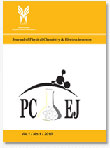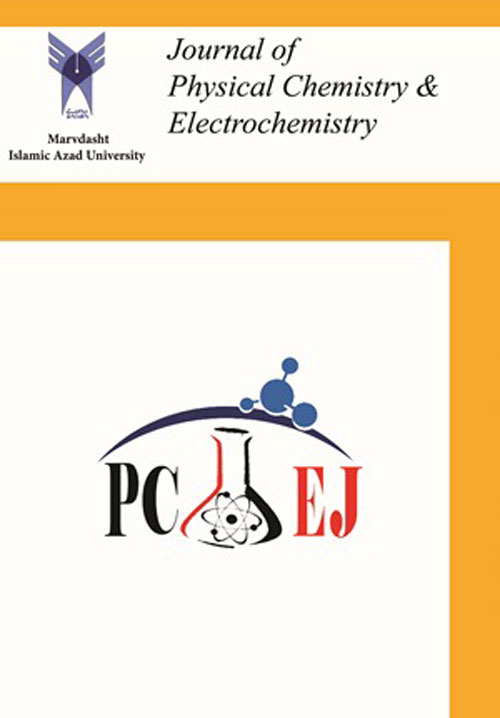فهرست مطالب

Journal of Physical Chemistry & Electrochemistry
Volume:1 Issue: 3, 2011
- تاریخ انتشار: 1390/06/15
- تعداد عناوین: 8
-
Page 117A new Schiff base 2-aminothiophenol furfural self assembled monolayer (SAM) has been fabricated on a bare gold electrode as a novel sensor for determination of dopamine. Electrochemical impedance spectroscopy was utilized to investigate the properties of the Au 2-aminothiophenol furfural self assembled monolayer modified electrode (Au ATF SAM-ME) using the [Fe(CN)6]3-/4- redox couple. The electrochemical behavior of dopamine on the Au ATF SAM-ME was studied by cyclic voltammetry and differential pulse voltammetry, using phosphate buffer solution as supporting electrolyte. The ascorbic acid has no response on the modified self-assembly electrode. A calibration curve was obtained for dopamine in a linear range of 2.0 × 10-6 to 1.0 × 10-4 M. The detection limit for dopamine was found to be 3.0 × 10-7 M. The results indicated that the Au ATF SAM-ME could be employed for the determination of dopamine in pharmaceutical formulations.
-
Page 123Propene dissociation channels were characterized by ab initio CCSD(T)/6-311++g(d,p) calculations. In this work the detailed mechanism of propene dissociation to C2H4+CH2, C2H2+H+CH3, C2H2+CH4 and C3H3+H2+H have been investigated. According to our calculations, ten fragments can be classified into five dissociated channels. Our results point out that two mechanisms come into play in the H2 elimination channels. These channels are responsible for the formation of CH2CCH. The C-C bonds rupture occur through three different channels.
-
Page 129Thermophysical properties of fluorine are interesting because of its applications in different areas of technology and industry. The computations of thermodynamic properties were performed with the GMA equation of state under critical conditions. The present work reports calculations of density, volumetric, and thermodynamic properties of liquid fluorine on extended ranges of pressure and temperature and the results show that GMA equation of state reproduces the experimental PVT data of fluorine within experimental errors throughout the liquid phase. The calculated results are different only a few percent from the experimental ones.
-
Page 139An analytical equation of state is applied to calculate the thermodynamic properties for argon. The equation of state is that of Song and Mason. It is based on a statistical-mechanical perturbation theory of hard convex bodies and can be written as fifth-order polynomial in the density. There exist three temperaturedependent parameters: the second virial coefficient, an effective molecular volume, and a scaling factor for the average contact pair distribution function of hard convex bodies. We used Lennard-Jones (12-6) potential for calculation temperature-dependent parameters. The equation of state has been applied to calculate thermodynamic properties including the internal energy, the enthalpy, the entropy, the heat capacity at constant pressure, and the speed of sound for argon. The theoretical results are in good agreement with the experimental data.
-
Page 145Stable crystalline phosphorus ylides are obtained in excellent yields from the 1:1:1 addition reaction between hydantoins or thiohydantoins and dialkyl acetylenedicarboxylates in the presence of triphenylphosphine. These phosphoranes undergo smooth intramolecular Wittig reaction followed by an electrocyclic ring opening to produce dialkyl (E)-2-(2,5-dihydro-5,5-diaryl-2-thioxo-1H-imidazol- 4-yl)fumarates and 2,5-Dihydro-5,5-diaryl-2-thio-1H-imidazoles in good yields. Dynamic effects were observed in the 1H NMR spectra of these compounds and were attributed to restricted rotation around the Carbon-Carbon single bonds. Rotational energy barrier (ΔG#) for their interconversion process of rotational isomers equals to (68.2 and 71.7) ± 2 kJ mol-1.
-
Page 149The application of conductive coatings on ferritic stainless steel can decrease electrical conductivity. The aim of this research was to investigate the electrical conductivity of cobalt coated AISI 430 ferritic stainless steel by pack cementation technique. Coated coupons were analyzed using scanning electron microscopy (SEM). Electrical conductivity of the coated substrates was measured as a function of temperature by oxidizing the samples from room temperature to 700 ºC. Also electrical conductivity has been measured as a function of oxidation time during isothermal oxidation at 700 ºC. Results showed the increase of temperature caused to the decrease of electrical conductivity and also, the coating layer converted to cobalt spinels during annealing in isothermal oxidation. The formation of MnCo2O4, CoCr2O4, CoFe2O4 and Co3O4 spinels improved electrical conductivity activation energy of coated substrates (0.03 eV) compared to uncoated substrates (0.039 eV).
-
Page 155Ethyl benzene used increasingly each year is the raw material of producing styrene monomer. This substance is produced from benzene alkylation with ethylene or ethanol, depending on the availability and cost of raw materials. In this study benzene alkylation in the presence of ethanol in a catalytic fixed bed reactor in three states of isotherm, adiabatic and non-isotherm-non-adiabatic is mathematically modeled with onedimensional pseudo- homogeneous model; and then has been programmed with math lab software. The reaction kinetics model is used in this study which comes from the experimental equations found by Mr. U.S Ridevi et al. in a zeolite catalyst impregnated with AlCl3 obtained in isotherm mode. The results of this simulation in isotherm state are comparable with experimental data. The adiabatic and non-isotherm-nonadiabatic states also show acceptable results. Furthermore, in this study the effect of various factors such as the feed flow rate, substrate temperature, substrate density, fixed and variable heat capacity and viscosity of fluid has been investigated.
-
Page 163In this study, a temperature-dependent of the dispersion coefficients is calculated from equation state. The Lennard-Jones LJ (12-6-3) effective pair potential function and simple thermodynamic argument with the input PVT data of liquid metals are used to calculate the dispersion coefficients. The dispersion coefficients (,, ) 3 6 12 C C C are found to be a linear function of 1/T1+α, where T is the temperature and α is a constant and has different values for different dispersion coefficients. The law of corresponding states based on the reduced dispersion coefficients and reduced temperature is used to verify the validity of a LJ (12-6-3) potential function in describing the dispersion coefficients. By applying the dispersion coefficients of alkali metals and potential function plots, the values of molecular parameters (å, ó, and, m r) have been obtained. The LJ (12-6-3) potential function conclusively predicts the best dispersion coefficients of the three alkali metals (K, Rb, and Cs).


